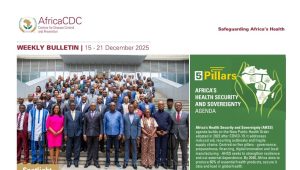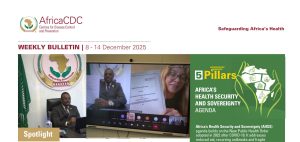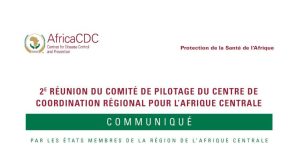National borders are not just geographical demarcations but critical frontlines in the fight against infectious diseases, especially deadly infections like COVID-19, mpox and marburg. Thus, in the era of unprecedented global mobility and interconnected economies, the role of border surveillance has become increasingly vital.
The Strategic Framework for Strengthening Cross-Border Surveillance and Information Sharing, developed by Africa CDC, provides a comprehensive blueprint for mitigating these challenges and safeguarding the continent’s health security.
It recognises that Africa, with its high levels of cross-border movement and porous borders, faces unique challenges in managing public health threats. Yet points of entry (PoEs), such as airports, seaports and ground crossings, are often ill-equipped to handle public health threats, posing significant risks to regional and global health security.
While the continent bears 24% of the world’s diseases, it accounts for only 3% of the global health workforce and less than 1% of global health expenditure. This disparity is exacerbated by the rapid movement of people, animals, and goods across borders, thereby facilitating the spread of infectious diseases.
By focusing on early detection, prevention, and coordinated response, the framework seeks to address vulnerabilities at PoEs and enhance the continent’s preparedness for health emergencies. It aligns with global health policies and integrates a One Health approach, recognising the interdependence of human, animal and environmental health.
The framework aims to build a unified cross-border health system capable of effectively responding to public health threats. Its objectives include strengthening governance and coordination mechanisms, enhancing the capacities of PoEs, improving data-sharing systems, and fostering community engagement.
It also prioritises monitoring population mobility to inform targeted health interventions. These objectives reflect a holistic and proactive approach to managing health risks associated with globalisation and environmental change.
Key Strategies for Implementation
The framework identifies six strategic pillars as foundational to its success The first pillar focuses on coordination and collaboration, advocating for the establishment of cross-border health committees and multi-sectoral partnerships. These mechanisms are designed to harmonise national and regional efforts, ensuring a cohesive response to health threats.
The second pillar emphasises capacity building at PoEs, highlighting the need for improved infrastructure, training, and resources This includes developing standard operating procedures and providing ongoing professional development for border health staff.
Data sharing and operational research form the third pillar, emphasising harmonising reporting protocols and leveraging digital technologies. Real-time data exchange is critical for timely decision-making and effective resource allocation.
The fourth pillar aims to strengthen laboratory and surveillance systems at PoEs, ensuring access to diagnostic facilities and integrating community-based surveillance networks Early warning systems are essential for detecting and mitigating potential outbreaks.
Risk communication and community engagement are central to the fifth pillar. Transparent communication strategies and active community involvement are vital for building public trust and countering misinformation during health crises.
The final pillar focuses on monitoring population mobility to identify patterns that may influence disease transmission. Mapping these dynamics provides valuable insights for designing targeted public health interventions and allocating resources effectively.
Challenges and Opportunities
While the framework addresses critical gaps in cross-border surveillance, it also acknowledges the challenges that hinder its implementation. Underfunded health systems, inadequate infrastructure and limited technical capacity at PoEs are significant barriers. Informal border crossings, which often lack proper screening and surveillance mechanisms, further complicate efforts to contain disease spread. Additionally, legal and logistical hurdles make seamless data sharing difficult.
However, the framework identifies numerous opportunities for improvement. The growing adoption of the One Health approach across Africa offers a platform for integrated health interventions. Regional networks and partnerships, such as those facilitated by Africa CDC and Regional Economic Communities (RECs), provide critical support for capacity building and policy alignment. Advancements in digital health technologies also present opportunities for real-time data collection and analysis, enhancing the continent’s preparedness for health emergencies.
Institutional Roles and Stakeholder Engagement
Africa CDC has identified a central role in implementing the framework, working closely with RECs, AU member states, and international partners. These stakeholders are tasked with integrating the framework into national health strategies, mobilising resources, and advocating for sustained investments in health security.
RECs, in particular, serve as key facilitators of regional coordination, aligning cross-border health initiatives with broader economic and political objectives. Development partners provide technical expertise and financial support, while community organisations and civil society groups play crucial roles in risk communication and local engagement.
Monitoring and Evaluation for Sustained Impact
The framework includes a robust monitoring and evaluation (M&E) system to track progress and ensure accountability. Using a Theory of Change approach, the M&E plan involves systematic data collection and stakeholder-inclusive evaluations. Regular assessments will inform adaptive strategies, ensuring interventions remain relevant and effective. Best practices and lessons learned will be documented to inspire innovation and continuous improvement. By sharing success stories and case studies, Africa CDC continues to work at strengthening a culture of learning and collaboration across the continent.
Full report: Strengthening Cross-Border Surveillance and Information Sharing in Africa







